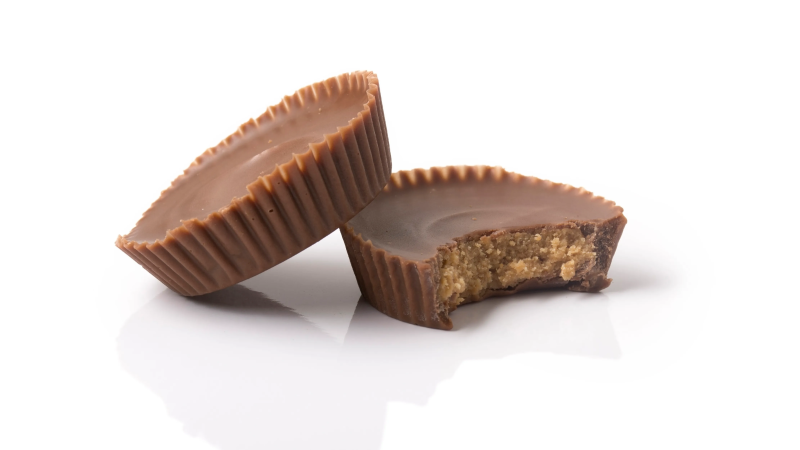What is the 'healthiest' Halloween candy? Don't get tricked by these other treats.
Are you more of an M&M or a Skittles person? Swedish Fish or Sour Patch Kids? Chocolate or gummies?
It’s October, which means it’s time to perfect your costumes and hit the store to stock up on candy for trick-or-treaters. It’s a season of spooky decorations and silly Halloween jokes, but some parents may feel Halloween is overshadowed by battling sugar-hyped kids and rationing leftover candy.
If you’re dreading the candy aspect of the annual spooky season, we’ve got some expert tips to make it a bit easier.

What is the healthiest Halloween candy?
Halloween candy doesn't provide much – if any – nutritional value. But these options rank above others, says Rose Britt, a registered dietitian with Top Nutrition Coaching.
The “healthiest” Halloween candy is Peanut M&Ms, Britt says, or a similar complex candy. When it comes to choices with multiple components, like peanuts, you’re getting at least a bit more substance than just corn syrup.
If we're really getting into the nitty-gritty, a serving of Peanut M&Ms contains a little less than 1 gram of fiber, 2 grams of protein and 9 grams of sugar. A similar-sized serving of Reese’s Peanut Butter Cups contains around the same nutritional value but a touch more added sugar and Snickers contain no fiber, 1 gram of protein and 9 grams of added sugar, according to nutrition labels.
“It’s not a whole balance, but it will give us a little more sense of fullness compared to our more traditional, straight-sugar type candies,” Britt says.
Peanut M&Ms are also made of mostly milk chocolate. Almond Joys, for comparison, are also made of nuts and chocolate but are mostly made of corn syrup. Looking at the first ingredient, which is the candy’s most abundant, is a good way to compare candies, Britt explains.
Candy with nuts is your healthiest option, but if you’re into sugary sweets, Smarties are the healthiest option. One serving of Smarties contains just 25 calories and 6 grams of sugar. For comparison, Sour Patch Kids contain 110 calories and 24 grams of sugar in one serving.
In general, candy provides little to no nutritional value and isn’t considered a "health" food. The Dietary Guidelines for Americans recommend limiting added sugars to less than 10% of total daily calories. The American Academy of Pediatrics recommends children over 2 limit their daily added sugar intake to less than 25 grams.
But Britt says this is more important for context rather than counting. Allowing yourself – and your children – to splurge on Halloween can help cultivate a healthier relationship with food.
“I would not count the grams of sugar, I don’t recommend counting grams of sugar day-to-day anyways but don’t stress about that on Halloween night,” Britt says. “Going forward, if you’ve got one or two servings (of candy) with dinner and then best you can limiting our sugar intake throughout the rest of the day, it puts it into context.”
150 Halloween jokes:Keep your family and friends in stitches this spooky season
How parents can manage Halloween candy for kids
Britt, whose focus is pediatric feeding, says the most important thing to remember is to make memories and enjoy spending the holiday with your family. But if you’re overwhelmed with how to set limits and keep your kids’ candy intake in check, here are a few things to keep in mind:
Set boundaries ahead of time
Having a game plan before the trick-or-treating begins is the best way to prepare. Britt recommends letting your kids “go crazy” on the night of and imposing limits in the days that follow – maybe one or two pieces per day.
She also recommends coming up with a deadline depending on the volume of candy your household rakes in.
“Maybe if they don’t have a ton of candy, ‘We’re going to do this until your Halloween candy runs out,’ or if they’ve got a ton of candy, ‘We’re going to do this until November 15,’” she proposes.
Plan a nutritious meal before trick-or-treating
Parents may not be able to control a free-for-all Halloween night, but they can control the balanced meal their family eats beforehand.
Britt recommends a protein and fiber-rich meal, even if it’s not a big one. Fiber contributes to balanced energy and reduces blood sugar spikes that lead to energy crashes. High-fiber foods include brown rice, quinoa, whole-grain pasta, pita bread and fruits and vegetables. Protein can help little trick-or-treaters stay fuller longer, and you can get lots of it from animal products like meat or plant-based foods like quinoa and soy.
“At least you’re packing some nutrients,” she says. “Those bites that they’re having at dinner can balance out a little bit of the sugar rush that’s going to happen later on in the evening.”
And even as the candy lingers in the following weeks – or months – parents can stay in the driver’s seat by stocking the fridge with fruits and veggies, whole grains, plant proteins and high-quality meat sources so balanced, nutritious meals are the focus of household eating.
Employ the “parent tax”
Parents may be familiar with the Halloween “parent tax” from a candy-hoarding standpoint – what parent doesn’t want to snag a few Milkyways for themselves?
Britt makes another argument: levy a toll on candy that isn’t safe for young children to eat yet.
“Up until the age of four, we want to be careful with nuts, hard candies, really sticky candy and gum,” she says. “That’s a nice way to weed out what might not be safe for those really younger kiddos, especially if parents think they might not be able to absolutely supervise them.”
Have leftover candy with the meal or snack, not after
It’s easy, and typical, to see candy as a treat or reward for good behavior. Britt argues against this tactic and recommends eating the allotted candy pieces with dinner instead of after it. It helps kids see their whole plate as good – veggies aren’t just something gross to get through to get to the good stuff. It also destigmatizes candy or sugar as “bad” or “junk food,” which can contribute to an unhealthy relationship with food. It may even help you avoid a pestering kid who can’t wait until after dinner to eat their candy.
“We can set ourselves up for that binging behavior if we internalize the shame of ‘I ate this bad candy so now I’m a bad person,’” she says.
If you’re having candy outside of a meal, she recommends putting screens and distractions away. Use your five senses to experience and savor the candy, which will have you feeling more satisfied after even just one piece.
Use it as a learning experience
You may not have thought of candy as a way to expose picky eaters to new foods, but there’s a way you can. Britt uses Almond Joys as an example, which can help introduce coconut or almond flavors. In the coming weeks, try a weeknight meal that uses the same ingredient – a coconut curry, perhaps – and have a conversation with them about the flavor across both foods.
“It’s a nice bridge versus … something that might be totally foreign to a kid who’s maybe a little more reserved or a little picky with trying new foods. When we see it in candy form, it’s a little more exciting.”
Repeated exposure to unfamiliar foods and creating a positive social experience during meals are proven methods for alleviating or avoiding picky eating behaviors, a journal article in the Centre for Academic Child Health found.
Discover more health tips for your daily diet:
- Healthiest fruit: This one has cognitive and cardiovascular benefits
- Healthiest vegetable: Check out these great nutrient-dense options
- Healthiest nut: Add these two daily for cognitive benefits and more
- Healthiest fast food: Look for this kind of menu next time you're out
- Healthiest bread: One is best, but your options for a healthy diet are aplenty
- Healthiest rice: Settling the white rice vs. brown rice debate
- Healthiest oil: Most have some benefits but these two might be best
- Healthiest beer: Consider these factors before you crack open a cold one
- Healthiest cereal: Inside the nutritional info on the back of the box
- Healthiest salad dressing:Best options, plus recipes to make your own
- Healthiest breakfast:Follow this 3-step guide in the mornings
- Healthiest butter:Look for this kind at the grocery store
- Healthiest deli meat:Guide for your next sandwich, plus during pregnancy
- Healthiest sugar substitute:Does one exist? Here’s what to know
- Healthiest ice cream:What to know before grabbing a “healthy” ice cream
- Healthiest snacks:Try these combos next time the hunger hits
- Healthiest meat:Expert tips to serve up a nutrient-rich plate
- Healthiest energy drink:What to know before you reach for another one
- Healthiest smoothie:Try out these ingredients in the blender
- Healthiest soda:The answer is tricky – here’s what to know
- Healthiest beans:Options for protein, fiber, iron intake
- Healthiest alcohol:Low-calorie, low-sugar options to try
- Healthiest water: How to sift through supermarket options
- Healthiest fats:You should be consuming more of this essential fat
- Healthiest Starbucks:Hacks to know at the order counter
- Healthiest diet:Why the answer encompasses more than just food
- Healthiest lunch:Use this guide for a foolproof healthy meal
- Healthiest chips:The salty details about baked, fried and homemade
Just Curious for more? We've got you covered
USA TODAY is exploring the questions you and others ask every day. From "Why do dogs lick you?" to "Are fairies real?" to "What is the oldest tree in the world?", we're striving to find answers to the most common questions you ask every day. Head to our Just Curious section to see what else we can answer for you.

Disclaimer: The copyright of this article belongs to the original author. Reposting this article is solely for the purpose of information dissemination and does not constitute any investment advice. If there is any infringement, please contact us immediately. We will make corrections or deletions as necessary. Thank you.







